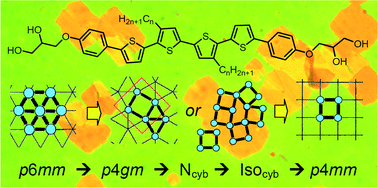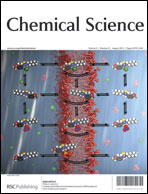Transition between triangular and square tiling patterns in liquid-crystalline honeycombs formed by tetrathiophene-based bolaamphiphiles†
Abstract
A series of 5,5′′′-diphenyl tetrathiophenes with polar glycerol groups at each end and two lateral flexible chains self-assemble into a series of liquid-crystalline honeycombs, formed by the π-conjugated rods which enclose polygonal prismatic cells filled by the lateral chains. With increasing chain length a discontinuous transition from triangular to square honeycombs takes place. At this transition a periodic honeycomb composed of a mixture of square and triangular cells in a ratio 1 : 2 was formed at low temperature, whereas at higher temperature a hexagonal columnar phase composed of triangular and randomly distributed rhombic cells, a new kind of cybotactic nematic phase, and also a cybotactic isotropic phase, both composed of square honeycomb fragments, represent the intermediate states. This provides an example of a dynamic self-assembled system where, depending on the molecular mobility, the transition between two periodic structures with different symmetry either leads to an increase of complexity, or to a chaotic regime with reduced order.


 Please wait while we load your content...
Please wait while we load your content...